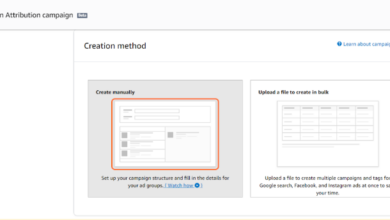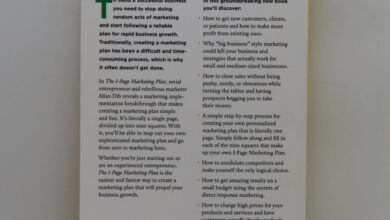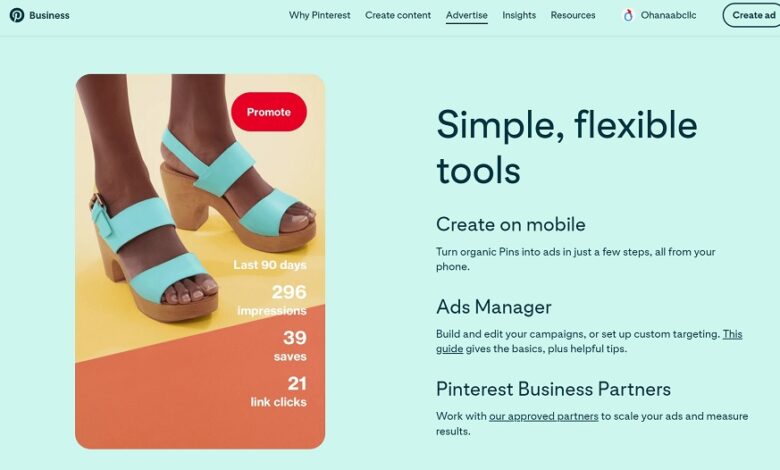
Pinterest Shopping Ads Your Guide to Success
Pinterest shopping ads offer a unique way to connect with your target audience. Unlike other platforms, Pinterest shopping ads focus on visual inspiration and discovery, making them ideal for driving traffic and sales for businesses of all sizes. This guide explores everything from crafting compelling ads to measuring success and understanding the platform’s strengths compared to competitors.
Pinterest shopping ads leverage the platform’s visual nature to showcase products in a way that resonates with users browsing for inspiration. This differs from other social media shopping ads which often prioritize immediate action. Understanding this unique approach is key to creating effective campaigns.
Introduction to Pinterest Shopping Ads
Pinterest shopping ads offer a unique way for businesses to connect with potential customers. Unlike other platforms that primarily focus on driving traffic to a website, Pinterest shopping ads are designed to directly showcase products and drive conversions. This focused approach allows businesses to showcase their products in visually appealing ways, ultimately leading to more sales.Pinterest’s algorithm prioritizes visual content, making it an ideal platform for showcasing products.
The platform’s strong emphasis on visual discovery and inspiration means that shopping ads are more likely to resonate with users compared to other platforms where the focus is often on text-based interactions.
Target Audience for Pinterest Shopping Ads
The Pinterest audience is highly engaged and interested in discovering new products and inspiration. Users typically browse Pinterest for ideas and inspiration related to a wide variety of topics, from home decor and fashion to food and crafts. This means the target audience for Pinterest shopping ads is likely to be composed of active users who are receptive to visual product displays and readily engage with product-focused content.
They are often in the research and discovery phase, making Pinterest shopping ads a valuable tool for attracting customers at a crucial stage of the buyer’s journey.
Key Benefits of Pinterest Shopping Ads
Pinterest shopping ads offer several advantages for businesses. Firstly, they allow businesses to showcase their products in a visually engaging way, highlighting product details and features in a format that aligns with Pinterest’s platform. This visual focus can result in increased brand awareness and product discovery. Secondly, Pinterest’s detailed targeting options allow businesses to reach the exact audience most likely to be interested in their products.
This level of targeted advertising can significantly improve return on investment (ROI) compared to other platforms. Lastly, the direct-to-purchase functionality allows users to quickly purchase products without leaving the Pinterest platform, resulting in a more seamless and efficient shopping experience.
Ad Formats for Pinterest Shopping Ads
Pinterest offers various ad formats for showcasing products. These include single-product ads, carousel ads that showcase multiple products, and collection ads that highlight a curated group of products. Each format serves a unique purpose, enabling businesses to present their products in different ways to appeal to various user preferences.
Typical Ad Structure for Pinterest Shopping Ads
The typical structure for Pinterest shopping ads includes a compelling image or video of the product, a concise and informative product title, a clear description of the product, and a clear call-to-action button to drive conversions. The ad’s visual aspect is crucial, as Pinterest users are highly visually driven. This structured approach to advertising maximizes the ad’s impact and encourages engagement and conversions.A well-structured ad often includes high-quality images or videos, highlighting key product features, and includes a clear call-to-action button, leading users directly to the product page or purchase option.
Measuring the Success of Pinterest Shopping Ads
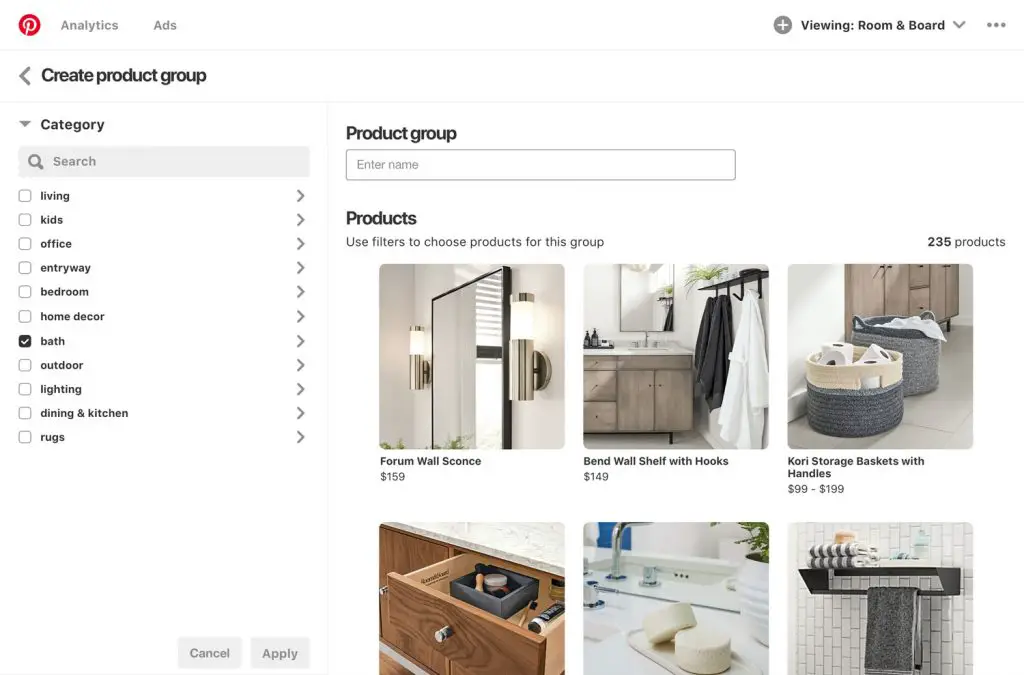
Pinterest Shopping Ads offer a unique opportunity to connect with highly engaged audiences. However, understanding how to effectively measure the performance of these campaigns is crucial for maximizing their impact. This involves more than just looking at clicks; it’s about evaluating the entire customer journey and identifying areas for optimization. Tracking key metrics, analyzing data, and leveraging available tools are all essential components of a successful Pinterest Shopping Ads strategy.Understanding the metrics that matter is paramount to evaluating the performance of your Pinterest Shopping Ads.
A successful campaign isn’t just about the number of impressions or clicks, but about the conversion rate and return on investment (ROI). Different metrics will hold different weight depending on your specific business goals. Focusing on the right KPIs will help you understand what’s working and what’s not, allowing you to refine your strategy and improve results.
Key Performance Indicators (KPIs) for Pinterest Shopping Ads
A variety of KPIs are available for evaluating the effectiveness of Pinterest Shopping Ads. These KPIs provide a comprehensive view of campaign performance and allow for informed decision-making. Essential metrics include click-through rate (CTR), conversion rate, cost per click (CPC), cost per acquisition (CPA), and return on ad spend (ROAS). Tracking these metrics consistently will give you a clear picture of the campaign’s profitability and areas needing improvement.
Pinterest shopping ads are a great way to drive traffic to your products, but boosting visibility across other platforms is key too. Want to supercharge your Instagram presence? Check out these 7 proven methods for getting more views on your feed 7 ways to hack the instagram algorithm and get way more views. Implementing these strategies can significantly improve your reach and ultimately, drive more sales through your Pinterest shopping ads campaigns.
By understanding and utilizing the strengths of different platforms, you can create a truly powerful online presence.
Tracking KPIs Related to Pinterest Shopping Ads
Implementing robust tracking mechanisms is vital for measuring the performance of Pinterest Shopping Ads. This involves setting up proper conversion tracking and utilizing Pinterest’s analytics tools. Integrating your Pinterest campaigns with your website analytics platforms (like Google Analytics) is essential for comprehensive data collection. This allows you to track conversions, such as purchases, leads, or sign-ups, that occur after a user clicks on your ad and lands on your website.
Analyzing Campaign Data to Identify Areas for Improvement
Analyzing your campaign data is crucial for identifying areas needing improvement. This involves scrutinizing the performance of different ad creatives, targeting options, and product listings. Tools like Pinterest Ads Manager and Google Analytics provide detailed reports that can be used to pinpoint which aspects of your campaigns are performing well and where there are opportunities for optimization. Regularly review and analyze the data to identify trends and patterns.
Pinterest Shopping Ad Analytics Tools and Resources
Pinterest Ads Manager is a powerful tool that provides a wealth of data and insights for Pinterest Shopping Ads. It allows you to track key metrics, create custom reports, and analyze campaign performance. Combining this data with data from other platforms like Google Analytics provides a comprehensive view of the customer journey and allows for informed decisions. Leveraging these resources is vital for optimizing campaigns and maximizing return on investment.
Interpreting Data Insights to Optimize Future Campaigns
Data insights are essential for optimizing future ad campaigns. Identifying patterns in campaign performance allows you to adjust targeting, ad creatives, and bidding strategies. Understanding which products, ad copy, or targeting options perform best helps you allocate resources effectively and improve future campaigns. For instance, if a particular product ad performs well in a specific demographic segment, you can focus more ad spend on similar segments.
Pinterest Shopping Ads Compared to Other Platforms
Pinterest shopping ads offer a unique approach to reaching visually-driven audiences. Understanding how they compare to other platforms like Instagram, Facebook, and Google is crucial for effective campaign strategy. This comparison highlights the strengths and weaknesses of each platform, enabling businesses to tailor their ad spend and maximize ROI.
Pinterest shopping ads are a fantastic way to drive sales, but nailing email marketing is crucial for conversions. If you’re struggling to get your emails delivered, check out this helpful guide on 15 reasons marketing emails go to spam and how to fix it. Understanding why your emails are landing in the spam folder can dramatically impact your Pinterest shopping ad campaign results.
Ultimately, effective email campaigns are key to boosting Pinterest shopping ad success.
Comparison of Pinterest Shopping Ads with Other Platforms
Pinterest stands apart from other social media shopping platforms by focusing on inspiration and discovery. Unlike platforms that prioritize immediate sales, Pinterest emphasizes long-term brand building and nurturing potential customers through visually engaging content. This approach results in a different user journey, with potential customers often engaging with pins before making a purchase. This is a key differentiator, driving a distinct strategy compared to platforms prioritizing immediate sales conversions.
Strengths and Weaknesses of Pinterest Shopping Ads
Pinterest’s strength lies in its visual focus, allowing brands to showcase products in an aesthetically pleasing way. This visual approach is ideal for items with strong design elements, such as clothing, home decor, or handmade crafts. The platform’s unique search function allows users to discover products based on their visual preferences, which translates into a higher conversion rate compared to other platforms, where users often navigate based on s.
Pinterest shopping ads are a game-changer for brands looking to connect with visually-driven shoppers. They’re a great way to drive traffic and sales, but understanding the nuances of the platform is key. Devika Mathrani, chief marketing officer at Wells Fargo, a leading figure in the financial industry , highlights the importance of targeted campaigns for maximum impact.
Ultimately, mastering Pinterest shopping ads requires a strategic approach to truly leverage the platform’s potential.
However, Pinterest’s reach isn’t as broad as Instagram or Facebook, and the platform may not be ideal for reaching a highly targeted audience.
Comparison of Strengths and Weaknesses Across Platforms
| Feature | ||||
|---|---|---|---|---|
| Visual Focus | Strong – Highlighting visual appeal is a core strength. | Moderate – Strong visual component, but not as visually focused as Pinterest. | Moderate – Primarily text-based, but visual elements are present. | Weak – Primarily text-based; focus is on search and text-based ads. |
| User Journey | Inspiration-driven – Users often discover products based on visual inspiration. | Direct response – Users often navigate toward immediate purchasing decisions. | Broad reach – Users have varied reasons for visiting the platform, leading to varied user journeys. | Search-driven – Users typically have a specific need or product in mind. |
| Targeting Options | Good – Tailored to specific interests and visual searches. | Excellent – Sophisticated targeting options based on demographics, interests, and behaviors. | Excellent – Comprehensive targeting options for demographics, interests, and behaviors. | Excellent – Advanced targeting based on s, demographics, and interests. |
| Cost-Effectiveness | Variable – Cost can fluctuate depending on competition and targeting. | Variable – Cost depends on the platform’s algorithm and campaign objectives. | Variable – Cost can be high if not targeted effectively. | Variable – Cost depends on competition, s, and bidding strategies. |
Cost-Effectiveness Comparison
| Platform | Cost-Effectiveness Analysis |
|---|---|
| Cost-effectiveness can vary depending on the campaign strategy and targeting. For example, a campaign focusing on visually appealing products with detailed descriptions and relevant s can achieve a higher return on ad spend (ROAS). | |
| Instagram advertising can be highly cost-effective when targeting specific demographics and interests. However, competition for ad space can drive up costs. | |
| Facebook’s broad reach and extensive targeting options can be advantageous for campaigns aimed at a large audience. However, high competition for ad space can lead to higher costs. | |
| Google Ads offer precise targeting based on search queries. The cost-effectiveness depends on the bidding strategy and competition. |
Trends and Future of Pinterest Shopping Ads
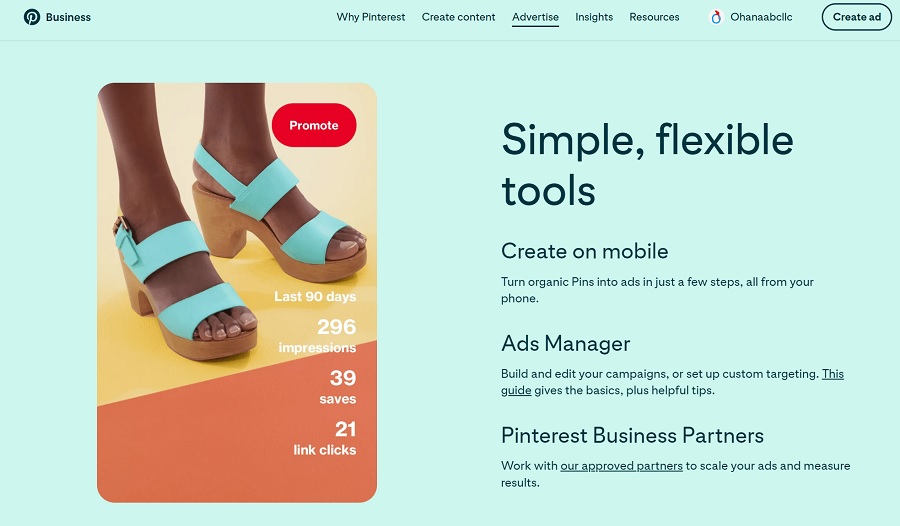
Pinterest shopping ads are rapidly evolving, driven by user behavior and platform enhancements. Understanding these trends is crucial for marketers to stay ahead of the curve and maximize their return on investment. The platform’s focus on visual discovery and community engagement is fueling innovative ways to connect with potential customers.The future of Pinterest shopping ads likely involves a greater emphasis on personalized experiences and dynamic content.
Marketers will need to adapt to this shift by creating targeted campaigns that resonate with individual users and leverage the platform’s unique capabilities.
Current Trends in Pinterest Shopping Ads
Pinterest’s user base actively engages with visually appealing content. This trend heavily influences the success of shopping ads. Users are drawn to high-quality images and videos, which showcase products in an attractive and engaging manner. A growing trend is the use of interactive elements within the ads, such as shoppable pins and video ads that allow users to quickly explore and purchase products.
Potential Future Developments in Pinterest Shopping Ad Features
Pinterest is expected to continue developing features that enhance the shopping experience. Improved search functionality, enabling users to easily find products based on specific criteria, is likely. The platform might also introduce more advanced targeting options, allowing for hyper-personalized campaigns that cater to individual user preferences. Integration with other platforms, like e-commerce platforms, could further streamline the purchasing process.
For instance, a seamless transition from browsing a product on Pinterest to adding it to a shopping cart on the retailer’s website is a plausible development.
Upcoming Changes to Pinterest Ad Policies or Guidelines
Pinterest is continuously refining its ad policies to maintain a user-friendly and trustworthy environment. Potential changes may involve stricter guidelines regarding misleading or deceptive advertising practices, to enhance user trust and encourage ethical advertising. More emphasis on transparency in product descriptions and pricing is also likely, to create a more transparent and fair shopping experience. Expect clearer definitions and guidelines for promoting products related to sensitive topics, like health or beauty.
Emerging Technologies Influencing Pinterest Shopping Ads
The integration of artificial intelligence (AI) and machine learning (ML) is predicted to play a significant role in shaping the future of Pinterest shopping ads. AI-powered tools can be used to personalize ad recommendations, enhance targeting, and improve the overall shopping experience for users. For instance, AI algorithms could analyze user browsing history to recommend products that align with their interests, creating a more engaging experience and driving conversions.
Augmented reality (AR) integration is also a possibility, allowing users to virtually try on products or visualize them in their own spaces. This interactive feature could dramatically increase engagement and drive sales.
Anticipated Evolution of Pinterest Shopping Ads
Pinterest shopping ads are projected to become more sophisticated and personalized. This evolution will focus on providing a more immersive and engaging shopping experience for users, incorporating innovative features and technologies. The platform is likely to emphasize the creation of visually appealing and interactive campaigns that cater to individual user preferences. The integration of emerging technologies, like AI and AR, is expected to enhance targeting and provide more engaging experiences.
This future evolution will make Pinterest shopping ads an increasingly powerful tool for businesses looking to reach a highly engaged and visually-driven audience.
Case Studies of Successful Pinterest Shopping Ads
Pinterest shopping ads offer a unique opportunity for businesses to connect with visually-driven audiences. Understanding how successful campaigns are structured and executed can provide valuable insights for your own strategies. This section dives into compelling case studies of businesses that have effectively leveraged Pinterest shopping ads to boost sales and brand visibility.
Success on Pinterest isn’t just about running ads; it’s about understanding the platform’s unique features and tailoring strategies to resonate with its users. These case studies highlight crucial elements, from targeting to creative assets, demonstrating how different businesses have adapted their approach for optimal results.
Examples of Businesses Leveraging Pinterest Shopping Ads
Several businesses have effectively used Pinterest shopping ads to drive significant returns. These examples showcase diverse approaches and highlight the adaptability of the platform for various industries.
“Pinterest shopping ads are more than just advertising; they’re a way to visually tell your brand story and connect with your target audience in a meaningful way.”
- Fashion Retailers: Companies like “Everlane” have used Pinterest shopping ads to showcase their products in visually appealing ways. Their strategy involved creating high-quality images and videos that highlight the craftsmanship and unique design features of their apparel. This approach attracted potential customers interested in sustainable and ethically-made clothing, driving considerable traffic to their online store and increasing sales.
- Home Goods Companies: “West Elm” effectively used Pinterest shopping ads to target users interested in interior design and home decor. Their campaigns featured stunning images of beautifully styled rooms, showcasing their furniture and accessories in context. By demonstrating how their products could enhance different home styles, they successfully attracted a wider audience and drove significant sales.
- Jewelry Designers: “Etsy” sellers, particularly those focused on handmade jewelry, have seen success using Pinterest shopping ads. Their strategy emphasizes showcasing the unique craftsmanship and intricate details of each piece. By highlighting the personal stories and emotions behind the designs, they captured the attention of customers seeking unique and meaningful gifts. The results included a substantial increase in website traffic and a noticeable uptick in sales.
Strategies Employed for Successful Campaigns
Successful Pinterest shopping ad campaigns often involve a combination of factors. The following strategies are commonly employed to achieve desired outcomes.
- High-Quality Visuals: Using visually engaging images and videos is paramount. High-resolution, well-lit photos that showcase products in attractive settings can significantly enhance click-through rates.
- Targeted Advertising: Precise targeting on Pinterest allows businesses to reach users interested in specific products or styles. This includes using relevant s, interests, and demographics to narrow down the audience.
- Compelling Product Descriptions: Concise and engaging descriptions that highlight key features and benefits of products can improve conversion rates. Adding details about materials, sizing, and care instructions can also be helpful.
- Strategic Pinning: Optimizing pins for visibility and relevance is essential. Using relevant s, high-quality visuals, and engaging captions can maximize the reach of your ads.
Results and Outcomes
The positive outcomes of these campaigns often include increased website traffic, higher conversion rates, and a significant boost in sales. Quantifiable results like these demonstrate the effectiveness of Pinterest shopping ads for businesses aiming to expand their reach and enhance their bottom line.
Troubleshooting Common Pinterest Shopping Ad Issues
Pinterest shopping ads offer a powerful way to reach potential customers, but like any advertising platform, issues can arise. Understanding these common problems and their solutions is key to maximizing your ad campaign’s effectiveness and preventing wasted budget. Knowing how to troubleshoot these issues quickly can help you stay on track with your marketing goals.Troubleshooting Pinterest shopping ads involves a systematic approach to identify and address any problems.
This includes checking campaign settings, ad creatives, and audience targeting, among other elements. A proactive approach is often more efficient than waiting for significant issues to impact your campaign.
Low Click-Through Rates (CTRs)
Poor click-through rates (CTRs) are a frequent concern for advertisers. Several factors can contribute to low CTRs, impacting the performance of your Pinterest shopping ads. Identifying the root cause is crucial to improving ad effectiveness.
- Unattractive ad creatives: If your ad visuals or copy are not compelling, users are less likely to click. Ensure high-quality images, clear calls to action, and relevant product information within the ad.
- Mismatched audience targeting: If your ads are shown to users who aren’t interested in your products, clicks will be low. Refine your targeting parameters to match your ideal customer profile.
- Inconsistent ad messaging: If your ad messaging doesn’t align with your product offerings or brand voice, users may be confused or disengaged. Ensure your ad copy and visuals accurately reflect your products and brand identity.
Low Conversion Rates
Low conversion rates can stem from several issues, making it difficult to achieve the desired results from your Pinterest shopping ads.
- Poor landing page experience: A slow-loading or confusing landing page can deter potential customers from completing a purchase. Ensure your landing page is user-friendly, easy to navigate, and optimized for conversions.
- High shopping cart abandonment: If customers add items to their cart but don’t complete the purchase, investigate the reasons behind this. Common issues include high shipping costs, lack of secure payment options, or a complicated checkout process.
- Inadequate product details: If your product listings lack detailed information, potential customers might be hesitant to buy. Provide high-quality images, detailed descriptions, and accurate pricing to increase trust and encourage conversions.
High Cost-Per-Click (CPC)
High cost-per-click (CPC) is a concern that often leads to budget overruns. Here’s a breakdown of the possible causes.
- Overly broad targeting: If your ad campaigns are reaching too many users who aren’t interested in your products, CPC will increase. Refine your targeting to focus on your ideal customer profile.
- High competition: If your industry or niche has many advertisers bidding on similar s, CPC will naturally increase. Consider adjusting your bidding strategy or targeting to compete effectively.
- Inadequate ad quality score: Pinterest’s algorithm assesses ad quality. Ads with low quality scores will have higher CPCs. Ensure your ad creatives, targeting, and landing pages meet Pinterest’s quality standards.
Table of Common Pinterest Shopping Ad Issues
| Issue | Cause | Solution |
|---|---|---|
| Low CTR | Unattractive creatives, mismatched targeting, inconsistent messaging | Improve ad visuals, refine targeting, ensure consistent messaging |
| Low Conversion Rate | Poor landing page experience, high cart abandonment, inadequate product details | Optimize landing page, address cart abandonment issues, provide detailed product information |
| High CPC | Overly broad targeting, high competition, low ad quality score | Refine targeting, adjust bidding strategy, improve ad quality score |
End of Discussion
In conclusion, Pinterest shopping ads offer a powerful tool for businesses looking to tap into a highly engaged audience. By understanding the platform’s nuances, crafting compelling visuals, and leveraging data-driven strategies, you can maximize your return on investment. This guide provides a comprehensive overview, equipping you with the knowledge and strategies to excel in the dynamic world of Pinterest shopping.
